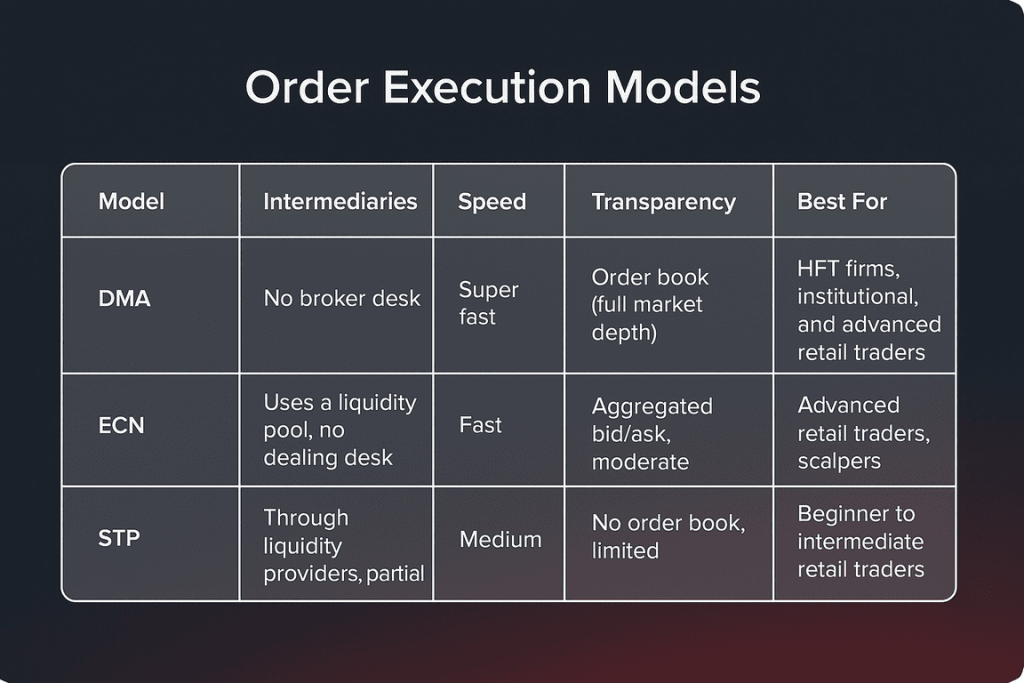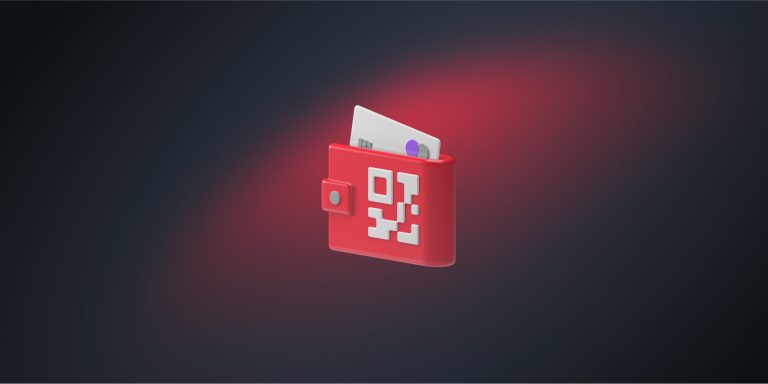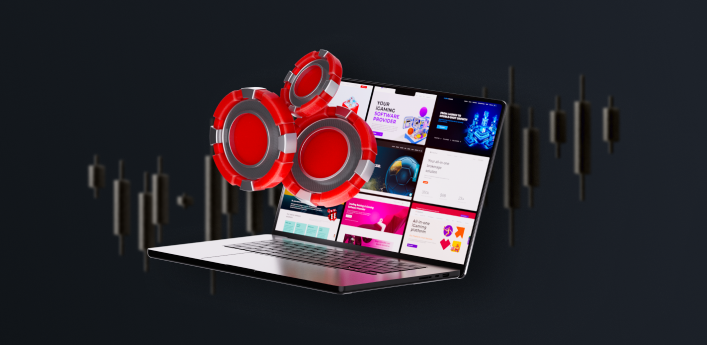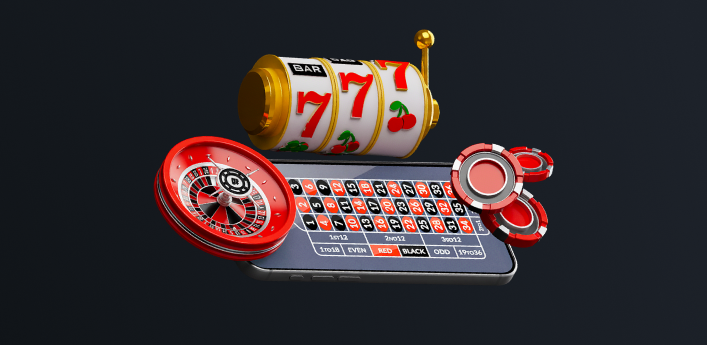
¿Qué es DMA (Acceso Directo al Mercado)?
Contenidos
El acceso directo al mercado (DMA) es un método de negociación que facilita el acceso directo a los participantes del mercado para enviar órdenes directamente a un libro de órdenes en una bolsa financiera sin la necesidad de la intervención de un corredor.
El DMA es más importante que nunca en el entorno comercial actual porque ofrece:
- Ejecución más rápida, lo cual es esencial para las estrategias de trading intradiario y de alta frecuencia.
- Transparencia de la profundidad del mercado y los precios en tiempo real
- Más control sobre los parámetros de tus operaciones, incluido el tiempo
Este método de negociación es frecuentemente utilizado por fondos de cobertura, traders algorítmicos y traders expertos que buscan mejorar el rendimiento en mercados de rápido movimiento.
Definición del acceso directo al mercado
El Acceso Directo al Mercado representa un enfoque innovador en el trading. Permite a los operadores introducir directamente órdenes de compra y venta en el libro de órdenes de una bolsa. Esta vía directa difiere del método en el que los brókeres median y ejecutan operaciones en nombre de los operadores. De esta forma, los operadores pueden aprovechar las condiciones del mercado con prontitud, sin las demoras que suelen asociarse con las transacciones gestionadas por brókeres.
El desarrollo del DMA ha progresado junto con los avances en la tecnología de trading. La evolución de los sistemas de trading no solo ha hecho posible el DMA, sino que también lo ha hecho excepcionalmente eficiente. Estos sistemas son especialmente beneficiosos para los inversores institucionales que buscan ejecuciones de operaciones rápidas y de gran volumen. A través del DMA, estos inversores pueden optimizar sus... estrategias comerciales garantizar eficazmente respuestas rápidas a los cambios del mercado.
El DMA ha impactado los mercados, generando cambios profundos. Garantiza que todos, desde inversores hasta operadores individuales, tengan las mismas oportunidades de acceder al mercado. Esta inclusión contribuye a la creación de un entorno comercial justo. Además, el DMA proporciona a los operadores una visión de los precios reales del mercado, lo que les permite tomar decisiones informadas basadas en datos fiables.
You may also like

¿Quién utiliza DMA?
El Acceso Directo al Mercado está dirigido a operadores que requieren una ejecución rápida, transparente y con la máxima flexibilidad. Es popular entre operadores profesionales o particulares que dependen en gran medida de la tecnología y el rendimiento en lugar del acceso a brókeres. Por lo tanto, sus principales usuarios son:
Comerciantes institucionales
Los fondos de cobertura, los fondos de pensiones y los gestores de activos utilizan el DMA para ejecutar órdenes de gran volumen sin que todo el mercado conozca sus intenciones. La interacción directa con el libro de órdenes ayuda a reducir el impacto en el mercado y a mejorar la ejecución.
Comerciantes minoristas avanzados
Los operadores individuales avanzados, en particular aquellos que utilizan análisis técnico o estrategias a corto plazo, eligen el DMA por la flexibilidad y el control que ofrece. Además, se benefician del acceso a una profundidad de mercado completa, mejores precios y la selección de tipos de órdenes y rutas específicas.
Empresas de trading algorítmico y de alta frecuencia
Para las empresas que operan con operaciones de trading automatizadas, cada milisegundo es crucial. El acceso directo al mercado les permite acceder a entornos donde pueden ejecutar miles de operaciones por segundo directamente con las API de los exchanges. Es un componente vital de las estrategias de trading algorítmico.
El acceso directo al mercado suele obtenerse a través de plataformas de negociación complejas ofrecidas por corredores e instituciones especializados. Las plataformas de negociación típicas integran datos en tiempo real, flexibilidad de enrutamiento y herramientas de ejecución adecuadas para contextos de negociación basados en datos y de alto volumen.
Cómo funciona el DMA
En esencia, el DMA funciona mediante sistemas de negociación electrónica que operan a velocidades increíbles. Cuando un operador ejecuta una orden mediante una plataforma DMA, esta se envía directamente al sistema de negociación de la bolsa. Esta transmisión directa evita las mesas de las casas de bolsa, eliminando intermediarios y posibles retrasos o errores manuales.
La tecnología detrás del DMA es compleja y se integra a la perfección con las estructuras existentes del mercado financiero. Estos sistemas brindan a los operadores acceso a información de precios en tiempo real, lo que les permite monitorear la profundidad del mercado y diversos datos al instante. Este acceso inmediato es invaluable para los operadores que dependen de los movimientos del mercado a corto plazo o que implementan estrategias de trading de alta frecuencia. Al observar las tendencias del mercado en tiempo real, pueden tomar decisiones rápidamente basadas en la información disponible.
La tecnología de DMA prioriza no solo la velocidad, sino también la precisión. El DMA permite la ejecución de órdenes para estrategias que se basan en puntos específicos de entrada y salida del mercado. La combinación de precisión y velocidad convierte al DMA en una herramienta valiosa para los operadores.
El DMA es especialmente útil cuando la velocidad de ejecución es crucial. Por ejemplo:
Imagine que un comerciante ve una caída repentina en EUR/USD después de que sale el número de inflación, y puede usar DMA para colocar instantáneamente una orden limitada en el libro de órdenes en el intercambio, lo que evita las demoras asociadas con el enrutamiento del corredor y ser estafado (con suerte) en un instante a un precio determinado.
Por último, los operadores institucionales suelen utilizar el DMA, que suele asociarse con informes de resultados o anuncios de bancos centrales. Un fondo de cobertura podría usar el DMA para ejecutar múltiples órdenes sobre diferentes activos en cuestión de segundos, ya que se trata de una cuestión de segundos en relación con la fluctuación del mercado, sin tener que esperar a que un bróker confirme la orden.
Con DMA, no hay terceros que se interpongan en el camino y un comerciante puede aprovechar oportunidades que se mueven rápidamente con mayor control, más rápido que con un método alternativo y con precisión, especialmente durante el movimiento de precios inducido por eventos de impacto en el mercado.
DMA vs. Trading tradicional ejecutado por bróker
La negociación tradicional ejecutada por un bróker y el acceso directo al mercado son dos métodos distintos para realizar transacciones en los mercados financieros. Analicémoslos en conjunto para comprender mejor el proceso general.
Velocidad de ejecución
DMAUna ventaja clave del DMA es su velocidad de ejecución. Al enviar órdenes al libro de órdenes de las bolsas sin pasar por la mesa de un bróker, la ejecución es instantánea. Esta agilidad resulta ventajosa para los operadores de alta frecuencia, quienes buscan aprovechar las fluctuaciones del mercado a corto plazo.
Operaciones ejecutadas por corredores tradicionalesLas órdenes pasan por la mesa de un corredor y pueden ser procesadas, especialmente en el caso de órdenes grandes o complejas. Este proceso puede generar retrasos en momentos de mayor actividad del mercado, lo que podría resultar en... deslizamiento , donde la orden se completa a un precio diferente al previsto.
Conclusión:DMA se destaca por sus tiempos de ejecución, lo que lo convierte en la opción favorita de los traders que buscan finalizaciones de órdenes precisas, como los day traders o scalpers.
Estructura de costos
DMA: DMA, que suele ofrecer menores costos de transacción, elimina la necesidad de la intervención de corredores en la ejecución de las operaciones. Los operadores que utilizan plataformas DMA podrían seguir incurriendo en comisiones. Estos costos suelen compensarse con las comisiones. Es importante que los operadores consideren los gastos relacionados con el mantenimiento de la tecnología y las fuentes de datos.
Operaciones ejecutadas por corredores tradicionalesLos brókers suelen cobrar comisiones o tarifas por operación, además de otras tarifas, especialmente si ofrecen servicios adicionales como investigación, asesoramiento o gestión de cartera. Estos gastos pueden acumularse para los operadores con un gran volumen de operaciones.
Conclusión: El DMA suele ser más rentable para operadores de alto volumen que no necesitan los servicios de los brókeres. Sin embargo, para quienes valoran la asistencia y la orientación personalizadas, los mayores costos asociados con el trading pueden justificar la contratación de un bróker.
Transparencia
DMA: El DMA ofrece a los operadores acceso al directorio de órdenes de las bolsas, lo que les permite ver los precios de compra y venta en tiempo real, así como la profundidad del mercado. Esta transparencia facilita la toma de decisiones y la comprensión de la dinámica del mercado.
Operaciones ejecutadas por corredores tradicionalesLos corredores suelen combinar varias órdenes antes de ejecutarlas en la bolsa, lo que puede ocultar las condiciones del mercado en tiempo real. Es posible que los operadores no siempre tengan acceso al libro de órdenes. Sepa los precios exactos a los que se ejecutarán sus órdenes.
Conclusión: DMA ofrece transparencia, lo cual es vital para los traders que dependen de información detallada del mercado para tomar decisiones informadas, especialmente aquellos que utilizan análisis técnico o estrategias de sentimiento del mercado.
Control sobre las transacciones
DMALos operadores tienen control total sobre sus órdenes, lo que les permite especificar los tipos de órdenes, los plazos y las condiciones de ejecución. Este nivel de autonomía es ventajoso para quienes buscan implementar estrategias o asegurar la ejecución.
Operaciones ejecutadas por corredores tradicionalesLos corredores suelen decidir cómo y cuándo ejecutar las órdenes, especialmente las de mercado. Si bien este enfoque de no intervención puede beneficiar a algunos operadores, puede suponer limitaciones para quienes desean controlar sus operaciones.
Conclusión: El DMA es más adecuado para operadores que requieren control sobre sus actividades y estrategias de trading. Por el contrario, la negociación tradicional ejecutada por un bróker podría ser preferible para operadores que confían en la experiencia de un bróker.
Consideraciones de accesibilidad
DMAAnteriormente, el DMA era accesible principalmente solo para inversores y grandes fondos de cobertura debido a los costos y las exigencias tecnológicas. Sin embargo, el auge de las plataformas de negociación ha hecho que el DMA sea más accesible también para los operadores, aunque aún requiere cierto nivel de capital y experiencia en trading.
Operaciones ejecutadas por corredores tradicionales: Las operaciones tradicionales ejecutadas por brókeres están ampliamente disponibles para operadores de todos los niveles, desde principiantes hasta profesionales. Los brókeres suelen ofrecer recursos, materiales de investigación y servicios de soporte que facilitan la participación de los operadores principiantes en los mercados.
Conclusión: Si bien el DMA tiene sus ventajas, puede que no sea adecuado para todos los operadores, ya sean principiantes o quienes necesitan apoyo adicional. Los brókeres tradicionales siguen atendiendo a un público mucho mayor de participantes del mercado.
DMA vs. ECN vs. STP: ¿Cuál es la diferencia?
En el comercio electrónico, el grado en que un modelo de ejecución de órdenes puede afectar los precios, la velocidad y la transparencia es considerable. Además, las implicaciones del modelo de ejecución de órdenes pueden ser enormes en estos tres modelos: Acceso Directo al Mercado (DMA), Red de Comunicación Electrónica (ECN) y Procesamiento Directo (STP), lo que a menudo genera confusión e intercambiabilidad de términos. Aun así, cada modelo ofrece un nivel diferente de accesibilidad y control.
Aquí hay una comparación rápida de los tres para que tengas una mejor comprensión visual:

Entonces, debes elegir:
- DMA si desea precisión, transparencia y control completo de la ejecución.
- ECN si desea precios competitivos y ejecuciones decentes sin necesidad de ver todo el libro de pedidos.
- De lo contrario, STP, si priorizas la facilidad de uso y no ejecutas estrategias complejas.
Beneficios de usar DMA
El DMA ha revolucionado el trading al ofrecer beneficios que optimizan el proceso. Desde la información del mercado hasta la rentabilidad, el DMA satisface las necesidades de los traders actuales. Profundicemos en estas ventajas para comprender cómo el DMA está transformando el panorama del trading.
Mayor transparencia
Una ventaja clave del Acceso Directo al Mercado es su nivel de transparencia, evidente en el acceso directo que proporciona al libro de órdenes del mercado. Los operadores pueden ver los precios de compra y venta en tiempo real, así como los volúmenes de órdenes, lo que les permite tomar decisiones de trading informadas y observar la dinámica del mercado. Esta visibilidad de la profundidad y liquidez del mercado es fundamental para las estrategias centradas en el análisis del sentimiento del mercado y las fluctuaciones de precios.
Ejecución rápida de operaciones
Además, el DMA es reconocido por su capacidad para agilizar la ejecución de operaciones sin problemas. Permite a los operadores enviar órdenes al mercado sin la intervención de una mesa de operaciones de una firma de corretaje. Esta ruta directa resulta beneficiosa en momentos de volatilidad del mercado, cuando los precios fluctúan rápidamente, lo que permite a los operadores aprovechar las oportunidades. La velocidad con la que el DMA ejecuta las operaciones contribuye a aprovechar las fluctuaciones de precios y a evitar el posible deslizamiento que pueden conllevar los métodos de ejecución más lentos.
Costos de transacción reducidos
Además, el DMA suele ser más rentable que otros métodos de trading. Al prescindir de intermediarios, el DMA reduce los costes de transacción, lo que lo convierte en una opción atractiva para los operadores con grandes volúmenes de negociación. El impacto conjunto de las comisiones por operación puede aumentar sustancialmente la rentabilidad y la eficiencia de las operaciones para los operadores activos.
You may also like

Control sobre las operaciones y reducción de la manipulación
Además de las ventajas, el DMA otorga a los operadores autonomía sobre sus operaciones. Pueden colocar órdenes directamente en el mercado, lo que les permite alinearse con mayor precisión con sus estrategias de trading y las condiciones imperantes. Además, reduce el riesgo de manipulación o sesgo de precios por parte de los brókeres, problemas que a veces se encuentran en... corredor de bolsa Configuraciones: otra ventaja de utilizar el DMA es su nivel de control y la reducción del sesgo. Este nivel de control y la reducción del sesgo resultan invaluables para los operadores que buscan transparencia e independencia en sus operaciones.
Consideraciones y riesgos del DMA
Si bien el DMA tiene tantos usos beneficiosos, los operadores deben sopesar los riesgos y las obligaciones que conlleva. Estos riesgos y obligaciones abarcan desde requisitos tecnológicos hasta requisitos operativos y de cumplimiento.
Requisitos tecnológicos
El DMA solo puede ejecutarse en una configuración de trading de alto rendimiento con una conexión a internet estable y de alta velocidad. Si un operador no cuenta con la tecnología necesaria para la ejecución directa, está sujeto a la latencia, la ejecución fuera de mercado o un fallo total de la configuración de trading en el peor momento (lo que podría impedirle aprovechar una oportunidad o incluso perder dinero).
Sin intervención del intermediario
El DMA proporciona total autonomía al operador. Esto significa que ninguna orden de compra o venta puede ser verificada ni ejecutada por un bróker. Tener control total conlleva riesgos con el tiempo, ya que el riesgo de error humano se acumula (por ejemplo, introducir una orden demasiado larga en un mercado de liquidación, comprar el tipo de orden incorrecto o operar con una posición demasiado grande en un mercado volátil). Este tipo de errores se vuelven increíblemente costosos.
Se requieren amplias habilidades
Los operadores deben poseer una habilidad considerable para ejecutar el DMA con eficacia. En concreto, deben comprender la profundidad del mercado, conocer los puntos de anclaje para entrar y salir de posiciones correctamente, y no contar con un bróker (o un intermediario) entre usted y el mercado al gestionar las posiciones abiertas. Por lo tanto, el proceso de adaptación para los operadores menos profesionales puede resultar abrumador y arriesgado a medida que navegan por todos estos nuevos niveles de complejidad.
Riesgo de impacto en el mercado
Se debe advertir a los operadores de DMA que, si realizan operaciones grandes sin dividirlas en órdenes más pequeñas mediante algoritmos, como harían con los brókeres, la propia operación podría influir en el precio del mercado. El riesgo de que un operador de DMA afecte el precio del mercado puede ser mayor si opera con órdenes de mayor tamaño en un mercado de baja liquidez, lo que facilita que una sola orden grande afecte el precio en contra de su posición.
Cumplimiento normativo
El acceso directo a las bolsas financieras (DMA) implica acceso inmediato y, por lo tanto, está sujeto a una estricta supervisión regulatoria. Los operadores están obligados a cumplir con regulaciones como MiFID II en Europa o la SEC en EE. UU., que regulan la calidad de la ejecución y la transparencia de precios, los requisitos de información y la gestión y el almacenamiento de datos. El incumplimiento de estas normas puede conllevar sanciones económicas o la suspensión del acceso.
Tendencias del DMA en 2025
A medida que los mercados maduran y las tecnologías comerciales evolucionan, el Acceso Directo al Mercado (DMA) también está cambiando rápidamente, priorizando la velocidad, la escalabilidad y la automatización. Se prevén varias tendencias emergentes en 2025 que impulsarán el futuro del DMA:
Estrategias de ejecución basadas en IA
Las ofertas de DMA incorporan cada vez más aprendizaje automático y algoritmos de ejecución basados en IA para optimizar la sincronización de las órdenes, reducir el deslizamiento y adaptarse a las condiciones de liquidez cambiantes en tiempo real. Esto permite a los operadores automatizar la integración de la toma de decisiones complejas dentro de un ecosistema de acceso directo.
Infraestructura de latencia ultrabaja
Ahora más que nunca, las empresas invierten considerablemente en conectividad de latencia cero, ubicación conjunta de bolsas y datos de mercado ultrarrápidos. El procesamiento de eventos en tiempo real implica que, cuanto mayor sea el tiempo transcurrido desde la señal hasta la ejecución, menos podrán los usuarios de DMA aprovechar la alta frecuencia, los arbitrajistas y otras estrategias de negociación.
Integración con Algo & API Trading
Las plataformas DMA ahora están integradas con motores de negociación algorítmica y API abiertas, lo que permite a los operadores institucionales y cuantitativos ejecutar con velocidad, escala y flexibilidad.
Democratización del DMA
En esencia, los fondos de cobertura ya no son la única opción disponible para funcionalidades de DMA complejas o avanzadas. Las plataformas de trading minorista ofrecen cada vez más un acceso simplificado al estilo DMA, lo que añade un grado de complejidad que permite a los operadores minoristas más expertos acceder a libros de órdenes en vivo y enrutamiento personalizable.
Automatización y cumplimiento
A medida que las regulaciones se vuelven cada vez más complejas en todo el mundo (por ejemplo, MiFID II y Dodd Frank, EMIR), los proveedores de DMA están incorporando herramientas relacionadas con el cumplimiento directamente en los sistemas comerciales, como vigilancia comercial, informes comerciales y enrutamiento inteligente de órdenes con reflejo de cumplimiento de las reglas jurisdiccionales.
En 2025, DMA será mucho más que velocidad: se trata de ejecución inteligente, infraestructura escalable y flexibilidad en tiempo real.
Conclusión
El Acceso Directo al Mercado (DMA) ha transformado el mundo del trading al ofrecer una combinación de eficiencia, transparencia y control que se adapta a las necesidades de los operadores. Si bien exige conocimiento del mercado e inversión tecnológica, sus beneficios son innegables. Con los avances tecnológicos en trading, el Acceso Directo al Mercado (DMA) es un ejemplo del progreso de la industria. Ofrece a los operadores un medio para operar de forma eficiente y aprovecha las oportunidades que presentan las tendencias del mercado.
FAQ
No exactamente. El DMA (Acceso Directo al Mercado) permite a los operadores enviar órdenes directamente a los libros de órdenes de las bolsas. Al mismo tiempo, la ECN (Red de Comunicación Electrónica) conecta las órdenes de compra y venta de múltiples partes, como bancos y otros operadores. Ambos se alejan de los brókeres tradicionales, pero el DMA ofrece mayor transparencia, procesamiento y control.
Sí, los traders minoristas avanzados pueden acceder a través de corredores que ofrecen DMA o plataformas comerciales, pero las cuentas minoristas a menudo necesitan saldos de cuenta más altos, más experiencia comercial y más conocimiento de ejecución o enrutamiento de órdenes.
El DMA ofrece a los operadores acceso directo a los libros de órdenes del mercado en vivo, mientras que el STP (procesamiento directo) recibe las órdenes de los clientes y las dirige automáticamente a los proveedores de liquidez en su nombre, sin supervisión ni intervención manual. En otras palabras, con el DMA, la transparencia y el control recaen más en las operaciones del cliente, en comparación con el STP, que, en mayor o menor medida, es más pasivo por diseño y automatizado.
Existen diversos brókeres de Acceso Directo al Mercado que prestan servicios a clientes institucionales y operadores minoristas avanzados, y que brindan acceso a bolsas globales, con infraestructura de baja latencia y acceso a toda la profundidad del mercado. Algunos son brókeres institucionales de primer nivel, mientras que otros son plataformas de negociación avanzadas que ofrecen acceso directo al mercado (DMA).
Actualizado:
28 de abril de 2025



